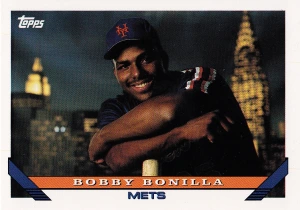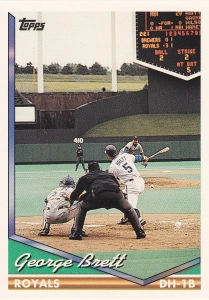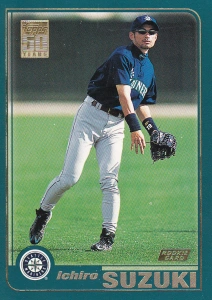The second Lifetime Topps set that I got completed amid the “retro haze of 2012” was 1990 Topps. I finished this set off back in May. I haven’t finished off the “Master Set” quite yet – just like 1989, it’s because there are some real insert sets now, and the K-Mart “Batting Leaders” inserts are tough to find at a decent price.
Info about my set:
How I put the set together:
- 458 cards from the wax box
- 84 cards from a couple of K-Mart blister pack
- 61 cards I already had from back in the day
- 189 cards from trades
Card that completed my set: #675 – Jim Abbott – GO BLUE!!! (1 of 2 cards I got in a trade with blog reader Kary that completed the set – the other was Tom Gordon).

Set composition: 792 cards (715 individual ML player cards*, 10 #1 Draft Picks, 26 Managers, 4 Ryan Tribute, 1 Giamatti Tribute, 5 Turn Back the Clock, 6 Checklists, 3 Record Breakers, 22 All-Stars)
*The 715 individual player cards include 10 All-Star Rookies and 5 Future Stars
Representation of ’88 MLB season: Out of the 715 player cards, 12 players featured did not play in the 1989 season. Four guys were prospects who just didn’t make the MLB roster (Bernie Williams, Delino DeShields, Luis Sojo, Mel Stottlemyre, Jr.). Six guys (Dave Winfield, Dale Sveum, Jose Guzman, Greg Mathews, Danny Cox, Rafael Santana) did not play in the majors in 1989 due to injury, but did get a card in the set. The last 2 players were in the minors for all of the 1989 season (Juan Nieves, Tom Lampkin). 2 players were in subsets and did play in the 1989 season – Mike Schmidt, who was featured on a Turn Back the Clock card, and first overall pick Ben McDonald was the only member of the Draft Pick subset to make the majors in 1989 – debuting 3 weeks after he was drafted by the Orioles.
The 705 players featured represent 71.4% out of the ~988 players who played in MLB in 1989.
Last active player from this set: #698 – Omar Vizquel

As of now, Vizquel is the only player from this set who is still active on an MLB roster. Jamie Moyer is the only other player in the set who also played in 2012. Considering that Moyer hasn’t officially retired, it’s possible he could end up outlasting Vizquel, though I think he may have thrown his last pitch in the Big Leagues. Of course, recent shenanigans by one Roger Clemens could throw all of this for a loop…
Player with the most cards in the set: Nolan Ryan – 5 cards:
Ryan – #1, #2-5 (Ryan Tribute)

This one was easy to figure out. For striking out 5,000 batters, Topps did something similar with Ryan that they did with Pete Rose in 1986 – they gave him the first card of the set and then did a tribute subset for the next few cards. These four subset cards all feature Ryan in each of his 4 Major League teams with the “5,000” in the background.
First Card and the Hundreds: #1 – Nolan Ryan, #100 – Will Clark, #200 – Don Mattingly, #300 – Bo Jackson, #400 – Ozzie Smith AS, #500 – Kevin Mitchell, #600 – Darryl Strawberry, #700 – Kirby Puckett

Highest book value: #692 – Sammy Sosa RC

Sosa’s rookie card books for a little bit more than the next card, which surprised me.
Most notable card: #414 – Frank Thomas FDP RC
Best card (my opinion): #414 – Frank Thomas FDP RC

I’m surprised that Thomas’s rookie card didn’t make it into the top 60 cards when Topps did the vote a few years ago. This one is notable first because it’s a rookie card for future back-to-back MVP award winner Frank Thomas. Second, is due to the famous error variation (No Name on the Front). No cards from the 1990 set made it into that Topps top 60. This set is often berated for the design, but this card is still very well-known.
In my opinion, this isn’t just the most notable card – I also think it’s the best. It’s the rookie card of an all-time great player, in his Auburn uniform. You can tell how big he is here, too – just look at the runner, Thomas is almost as tall as him while kneeling!
Second best card (also my opinion): #1 – Nolan Ryan

I could easily put this one above the Thomas. It’s the first card in the set, and it’s a great shot of Nolan. The photo actually goes really well with the design, too – which is really saying something.
Best subset card: #7 – Rickey Henderson RB

The Record Breakers subset has always been one of my favorites, and while there are only 3 RB cards in the 1990 set, this Rickey card is for a pretty cool record – the most home runs leading off a game. He broke the record of 35 held by Bobby Bonds in early 1989, but I find it interesting they actually talk about his last one of the season (his 40th) on the back of this card. I guess at the time, that was the new record. Kind of like McGwire’s 70th being more valuable than #62. Regardless, it’s a great photo of Rickey going deep.
Favorite action photo: #300 – Bo Jackson

Another Auburn alumni! Bo didn’t spend a ton of time in Major League Baseball – but he has some of the best cards around. This set doesn’t have a ton of action shots, so a shot of Bo at the point of impact is a pretty easy winner.
Favorite non-action photo: #230 – Keith Hernandez

I originally wanted to put Pascual Perez on here solely for his insane jheri curl. But this shot of Hernandez in the on deck circle was way too good.
My Favorite Reds card: #260 – Eric Davis

I’m pretty predictable – Eric Davis was my favorite Red around the time of this set, and he seems to win most of these contests. He’s actually won 3 in a row, and I haven’t done 1991 yet – so he could win that one, too. Some of the others were tougher picks – this one is a no brainer because a) it’s an awesome photo of Davis, and b) because there isn’t a lot of competition. I don’t even know what card would be second here.
Topps Reprints and others:
- 1999 Ryan reprints – Nolan Ryan
- 2001 Through the Years – Sammy Sosa
- 2001 Archives – Darrell Evans, Bob Boone, Keith Hernandez, Dan Quisenberry
- 2001 Archives Rookie Reprints – Frank Thomas, Williams, Sosa, Juan Gonzalez
- 2001 Topps Traded – Dave Justice
- 2002 Archives – Ryne Sandberg
- 2002 Gallery Heritage – Sosa
- 2003 Gallery Heritage – Williams
- 2005 Rookie Cup Reprints – Gary Sheffield, Ken Griffey Jr., Jim Abbott, Gregg Jefferies, Tom Gordon
- 2005 Gallery Heritage – Curt Schilling, Nolan Ryan HL
- 2010 CMT – Thomas, Thomas NNOF, Larry Walker
- 2011 60YOT – Williams, Schilling
- 2011 Lineage Autographed Reprints – Ryan
- 2013 Manufactured Commemorative Patch – Thomas
Due to the popularity of that error card, Frank Thomas has the most with 4 reprints. Sammy Sosa and Bernie Williams have 3.
Other Notable Cards: #505 – Pete Rose MG, #233 – Gregg Jefferies RC, #343 – Gary Sheffield RC

Juan Gonzalez was the other notable rookie card in the set (though I guess you could argue so is Bernie Williams). Griffey and Belle have 2nd year cards, though this is their first card in the base Topps set (for Belle it’s his first Topps card, period). And the Giamatti is notable – it was done to honor the commissioner’s passing away in the fall of 1989.
 Brewery: (Originally) Liebmann Breweries, New York, NY
Brewery: (Originally) Liebmann Breweries, New York, NY How it’s related to baseball: Rheingold was the original beer sponsor for the Mets. The beer was the only sponsor on the scoreboard while the team was in the Polo Grounds (during their first two years of existence). The “H” and the “E” would light up for hit and error official scoring, a take off the Schaefer sign at Ebbets Field that did the same thing.
How it’s related to baseball: Rheingold was the original beer sponsor for the Mets. The beer was the only sponsor on the scoreboard while the team was in the Polo Grounds (during their first two years of existence). The “H” and the “E” would light up for hit and error official scoring, a take off the Schaefer sign at Ebbets Field that did the same thing.






































































